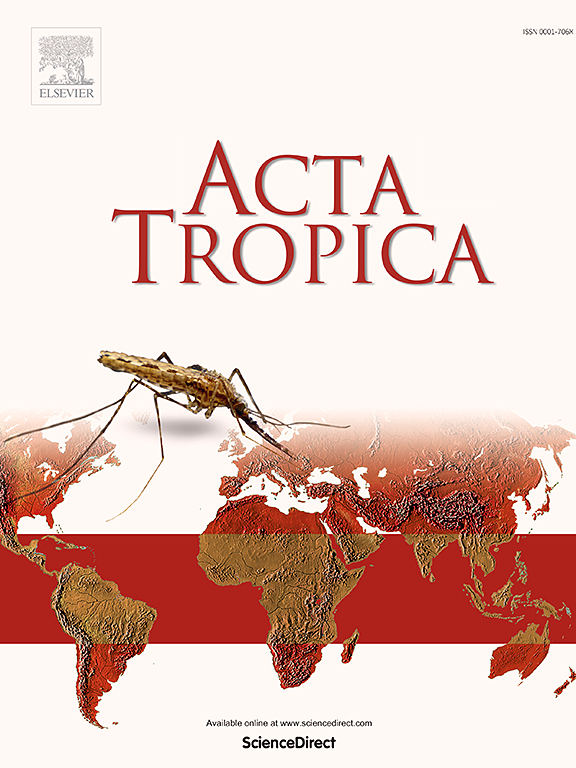Sequencing and description of mitochondrial genome of Coquillettidia venezuelensis, Trichoprosopon digitatum and Uranotaenia calosomata (Diptera: Culicidae)
IF 2.1
3区 医学
Q2 PARASITOLOGY
引用次数: 0
Abstract
Mosquitoes constitute a monophyletic taxon with approximately 3,700 species, widely distributed across continents and recognized as primary vectors of various infectious agents. Despite their medical importance, limited information is available on the evolutionary biology and molecular taxonomy of many mosquito species. In this study, we report the complete mitochondrial genome sequences of Coquillettidia venezuelensis Theobald, 1912, Trichoprosopon digitatum Rondani, 1848, and Uranotaenia calosomata Dyar & Knab, 1907, collected from the Brazilian Amazon. Sequencing was performed using the NextSeq 500 platform, resulting in genomes averaging 15,329 bp in length, comprising 37 functional subunits (13 PCGs, 22 tRNA, and 2 rRNA) and an A+T-rich control region. Comparative analyses revealed conserved genome organization, codon usage bias favoring AT-rich codons, and evidence of purifying selection acting on PCGs. Notably, a unique tRNA gene rearrangement was identified in Tr. digitatum, supporting its association with the Sabethini tribe. Phylogenetic reconstruction using concatenated PCGs confirmed the monophyly of major mosquito lineages, corroborating current taxonomic classifications and previous molecular and morphological studies. Our findings enrich the genetic resources available for Culicidae, contributing to improved molecular taxonomy and evolutionary understanding of these taxa. Additionally, this study highlights the potential of using transcriptomic data to recover mitochondrial genomes, offering a valuable tool for future systematic and eco-epidemiological research. Integration of mitochondrial data with nuclear markers and expanded taxonomic sampling is recommended to enhance resolution of deeper phylogenetic relationships within Culicidae.

委内瑞拉Coquillettidia venezuela, digitatum Trichoprosopon和calosomata Uranotaenia calosomata线粒体基因组的测序和描述(双翅目:库蚊科)。
蚊子是一种单系分类单元,大约有3700种,广泛分布在各大洲,被认为是各种传染性病原体的主要媒介。尽管它们在医学上很重要,但关于许多蚊子物种的进化生物学和分子分类学的信息有限。在这项研究中,我们报道了Coquillettidia venezuela ensis Theobald(1912)、Trichoprosopon digitatum Rondani(1848)和Uranotaenia calosomata Dyar & Knab(1907)采集自巴西亚马逊地区的线粒体全基因组序列。使用NextSeq 500平台进行测序,得到平均长度为15,329 bp的基因组,包括37个功能亚基(13个PCGs, 22个tRNA和2个rRNA)和一个富含A+ t的控制区。比较分析揭示了保守的基因组组织,密码子使用偏向于富含at的密码子,以及纯化选择作用于PCGs的证据。值得注意的是,一种独特的tRNA基因重排在Tr. digitatum中被发现,支持其与Sabethini部落的联系。利用串联PCGs进行的系统发育重建证实了主要蚊子谱系的单系性,证实了目前的分类分类和先前的分子和形态学研究。我们的发现丰富了库蚊科的遗传资源,有助于改进这些分类群的分子分类学和进化认识。此外,本研究强调了利用转录组学数据恢复线粒体基因组的潜力,为未来的系统和生态流行病学研究提供了有价值的工具。建议将线粒体数据与核标记和扩展的分类抽样相结合,以提高库蚊科内部更深层次系统发育关系的分辨率。
本文章由计算机程序翻译,如有差异,请以英文原文为准。
求助全文
约1分钟内获得全文
求助全文
来源期刊

Acta tropica
医学-寄生虫学
CiteScore
5.40
自引率
11.10%
发文量
383
审稿时长
37 days
期刊介绍:
Acta Tropica, is an international journal on infectious diseases that covers public health sciences and biomedical research with particular emphasis on topics relevant to human and animal health in the tropics and the subtropics.
 求助内容:
求助内容: 应助结果提醒方式:
应助结果提醒方式:


